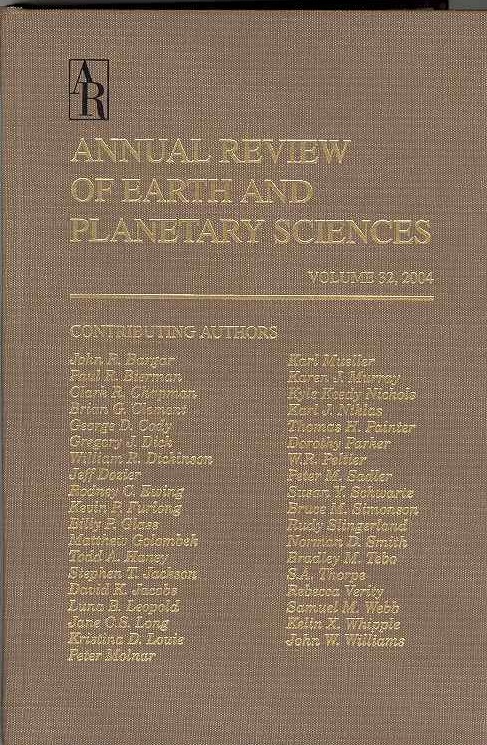大气中O2在显生宙的演化,再访
IF 13
1区 地球科学
Q1 ASTRONOMY & ASTROPHYSICS
Annual Review of Earth and Planetary Sciences
Pub Date : 2023-01-06
DOI:10.1146/annurev-earth-032320-095425
引用次数: 7
摘要
富氧大气对复杂动物来说是必不可少的。早期的地球有一个缺氧的大气层,了解高氧水平的上升和维持对于研究是什么推动了我们自己的进化和评估系外行星的可居住性至关重要。越来越多的技术旨在重现显生宙(过去5.39亿年)期间氧气水平的变化。我们评估这些方法,并试图绘制可靠的技术在一起,以形成一个共识显生宙O2曲线。我们的结论是,在寒武纪,氧气可能占大气的5-10%左右,在泥盆纪,氧气脉冲上升到15-20%,在二叠纪-石炭纪达到超过25%的峰值,然后下降到今天。寒武纪和奥陶纪的进化辐射似乎与氧气驱动相一致,而泥盆纪的“鱼类时代”与氧气上升到15%大气压以上相吻合。▪富氧大气对人类等复杂动物来说是必不可少的。▪我们回顾了重建过去5.39亿年间(显生宙)氧含量变化的方法。▪我们产生了一个最可能的大气含氧量演变的共识图。■寒武纪、奥陶纪和泥盆纪的进化辐射可能与氧浓度的上升有关。《地球与行星科学年鉴》第51卷的最终在线出版日期预计为2023年5月。修订后的估计数请参阅http://www.annualreviews.org/page/journal/pubdates。本文章由计算机程序翻译,如有差异,请以英文原文为准。
Evolution of Atmospheric O2 Through the Phanerozoic, Revisited
An oxygen-rich atmosphere is essential for complex animals. The early Earth had an anoxic atmosphere, and understanding the rise and maintenance of high O2 levels is critical for investigating what drove our own evolution and for assessing the likely habitability of exoplanets. A growing number of techniques aim to reproduce changes in O2 levels over the Phanerozoic Eon (the past 539 million years). We assess these methods and attempt to draw the reliable techniques together to form a consensus Phanerozoic O2 curve. We conclude that O2 probably made up around 5–10% of the atmosphere during the Cambrian and rose in pulses to ∼15–20% in the Devonian, reaching a further peak of greater than 25% in the Permo-Carboniferous before declining toward the present day. Evolutionary radiations in the Cambrian and Ordovician appear consistent with an oxygen driver, and the Devonian “Age of the Fishes” coincides with oxygen rising above 15% atm. ▪ An oxygen-rich atmosphere is essential for complex animals such as humans. ▪ We review the methods for reconstructing past variation in oxygen levels over the past 539 million years (the Phanerozoic Eon). ▪ We produce a consensus plot of the most likely evolution of atmospheric oxygen levels. ▪ Evolutionary radiations in the Cambrian, Ordovician, and Devonian periods may be linked to rises in oxygen concentration. Expected final online publication date for the Annual Review of Earth and Planetary Sciences, Volume 51 is May 2023. Please see http://www.annualreviews.org/page/journal/pubdates for revised estimates.
求助全文
通过发布文献求助,成功后即可免费获取论文全文。
去求助
来源期刊

Annual Review of Earth and Planetary Sciences
地学天文-地球科学综合
CiteScore
25.10
自引率
0.00%
发文量
25
期刊介绍:
Since its establishment in 1973, the Annual Review of Earth and Planetary Sciences has been dedicated to providing comprehensive coverage of advancements in the field. This esteemed publication examines various aspects of earth and planetary sciences, encompassing climate, environment, geological hazards, planet formation, and the evolution of life. To ensure wider accessibility, the latest volume of the journal has transitioned from a gated model to open access through the Subscribe to Open program by Annual Reviews. Consequently, all articles published in this volume are now available under the Creative Commons Attribution (CC BY) license.
 求助内容:
求助内容: 应助结果提醒方式:
应助结果提醒方式:


